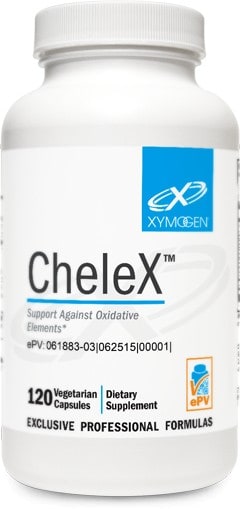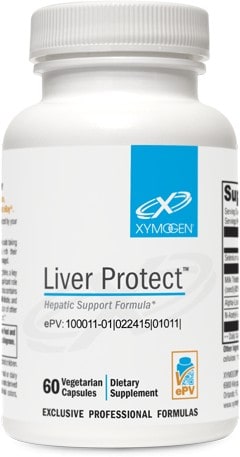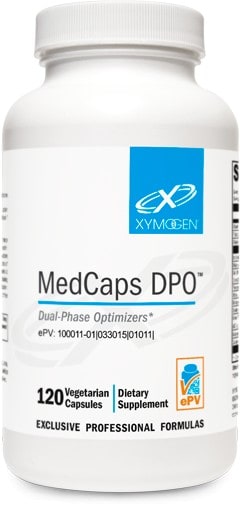Опис
Інструкція по застосуванню
Приймати дві-чотири капсули в день, або ж приймати за призначенням лікаря.
Проконсультуйтеся із лікарем перед вживанням. Пацієнтам, які вживають антикоагулянти, інсулін чи інші ліки, слід обговорити потенційну взаємодію із лікарем. Не приймати, якщо ви вагітні чи годуєте грудним молоком. Не вживати, якщо упаковку пошкоджено.
Склад
120 капсул в упаковці
| Розмір порції: 4 капсули | Кількість на порцію | % Денна норма |
|---|---|---|
| Екстракт гімалайського муміє (Asphaltum punjabinum) (органо-мінеральний екстракт) (50% фульвокислоти) | 600 mg | ** |
| Кальцій-динатрієва сіль ЕДТА | 300 mg | ** |
| Хлорела (Chlorella vulgaris) | 300 mg | ** |
| Водний розчин екстракту коріандру (Coriandrum sativum) (листя) | 300 mg | ** |
| N-ацетил-L-цистеїн | 200 mg | ** |
| Альфа-ліпоєва кислота | 100 mg | ** |
| Аліцин (екстракту часнику) (Allium sativum) (цибулина) | 6 mg | ** |
Всі формули XYMOGEN® відповідають стандартам якості GMP.
Умови зберігання
Зберігати щільно закритим у прохолодному, сухому місці, за межами досяжності для дітей.
Не містить
Пшениці, клейковини, дріжджів, сої, продуктів тваринного походження чи молочних продуктів, риби, креветок, арахісу, лісових горіхів, яєць, штучних барвників, штучних цукрозамінників чи штучних консервантів.
Інші складові
Гіпромелоза (капсула), стеаринова кислота, мікрокристалічна целюлоза, стеарат магнію та діоксид кремнію.
Список літератури
- Carrasco-Gallardo C, Guzmán L, Maccioni RB. Shilajit: a natural phytocomplex with potential procognitive activity. Int J Alzheimers Dis. 2012;2012:674142. [PMID: 22482077]
- Mittal P, Kaushik D, Gupta V. Therapeutic potentials of “shilajit rasayana”: a review. Int J Pharm Clin Res. 2009;1(2):47-49. http://www.rudramani.com/research/shilajit-as-amedicine-for-general-physical-strengthening-anti-aging-and-much-more.pdf. Accessed August 1, 2014.
- Bhattacharya SK, Sen AP, Ghosal S. Effects of shilajit on biogenic free radicals. Phyto Res. 1995 Feb;9(1):56-59. doi:10.1002/ptr.2650090113.
- Glynn AW. Fulvic and humic acids decrease the absorption of cadmium in the rat intestine. Arch Toxicol. 1995;70(1):28-33. [PMID: 8750902]
- Lind Y, Glynn AW. The influence of humic substances on the absorption and distribution of cadmium in mice. Pharmacol Toxicol. 1999 Jun;84(6):267-73. [PMID: 10401728]
- Gondar D, Lopez R, Fiol S, et al. Cadmium, lead, and copper binding to humic acid and fulvic acid extracted from an ombrotrophic peat bog. Geoderma. 2006 Nov;135:196-203. doi:10.1016/j.geoderma.2005.12.003.
- Sharma P, Jha J, Shrinivas V, et al. Shilajit: evaluation of its effects on blood chemistry of normal human subjects. Anc Sci Life. 2003 Oct;23(2):114-9. [PMID: 22557121]
- Hudák A, Náray M, Nagy I, et al. Effect of the consumption of humic acid with bound complex micro elements in cases of occupational cadmium exposure. National Institute of Occupational Health, Budapest, Hungary. http://www.omfi.hu/cejoem/Volume3/Vol3No3/ ce973-2.HTM. Accessed July 31, 2014.
- Foreman H, Trujillo TT. The metabolism of C14 labeled ethylenediaminetetraacetic acid in human beings. J Lab Clin Med. 1954 Apr;43(4):566-71. [PMID: 13163555]
- Shiels DO, Thomas DL, Kearley E. Treatment of lead poisoning by edathamil calciumdisodium. AMA Arch Ind Health. 1956 May;13(5):489-98. [PMID: 13312679]
- Besunder JB, Super DM, Anderson RL. Comparison of dimercaptosuccinic acid and calcium disodium ethylenediaminetetraacetic acid versus dimercaptopropanol and ethylenediaminetetraacetic acid in children with lead poisoning. J Pediatr. 1997 Jun;130(6):966-71. [PMID: 9202621]
- Aga M, Iwaki K, Ueda Y, et al. Preventive effect of Coriandrum sativum (Chinese parsley) on localized lead deposition in ICR mice. J Ethnopharmacol. 2001 Oct;77(2-3):203-08. [PMID: 11535365]
- Sharma V, Kansal L, Sharma A. Prophylactic efficacy of Coriandrum sativum (Coriander) on testis of lead-exposed mice. Biol Trace Elem Res. 2010 Sep;136(3):337-54. [PMID: 19902160]
- Aslani MR, Najarnezhad V, Mohri M. Individual and combined effect of meso-2,3- dimercaptosuccinic acid and allicin on blood and tissue lead content in mice. Planta Med. 2010 Feb;76(3):241-44. [PMID: 19764011]
- Senapati SK, Dey S, Dwivedi SK, et al. Effect of garlic (Allium sativum L.) extract on tissue lead level in rats. J Ethnopharmacol. 2001 Aug;76(3):229-32. [PMID: 11448543]
- Shahsavani D, Baghshani H, Alishahi E. Efficacy of allicin in decreasing lead (Pb) accumulation in selected tissues of lead-exposed common carp (Cyprinus carpio). Biol Trace Elem Res. 2011 Sep;142(3):572-80. [PMID: 20711682]
- Najar-Nezhad V, Aslani MR, Balali-Mood M. Evaluation of allicin for the treatment of experimentally induced subacute lead poisoning in sheep. Biol Trace Elem Res. 2008 Winter;126(1-3):141-7. [PMID: 18719860]
- Jiang W, Liu D, Hou W. Hyperaccumulation of cadmium by roots, bulbs and shoots of garlic (Allium sativum L.). Bioresour Technol. 2001 Jan;76(1):9-13. [PMID: 11315815]
- Lee JH, Kang HS, Roh J. Protective effects of garlic juice against embryotoxicity of methylmercuric chloride administered to pregnant Fischer 344 rats. Yonsei Med J. 1999 Oct;40(5):483-9. [PMID: 10565261]
- Melino S, Sabelli R, Paci M. Allyl sulfur compounds and cellular detoxification system: effects and perspectives in cancer therapy. Amino Acids. 2011 Jun;41(1):103-12. [PMID: 20213447]
- Queiroz ML, Rodrigues AP, Bincoletto C, et al. Protective effects of Chlorella vulgaris in lead-exposed mice infected with Listeria monocytogenes. Int Immunopharmacol. 2003 Jun;3(6):889-900. [PMID: 12781705]
- Uchikawa T, Maruyama I, Kumamoto S, et al. Chlorella suppresses methylmercury transfer to the fetus in pregnant mice. J Toxicol Sci. 2011 Oct;36(5):675-80. [PMID: 22008543]
- Vassallo DV, Simões MR, Furieri LB, et al. Toxic effects of mercury, lead and gadolinium on vascular reactivity. Braz J Med Biol Res. 2011 Sep;44(9):939-46. [PMID: 21845340]
- Flora SJ, Pande M, Mehta A. Beneficial effect of combined administration of some naturally occurring antioxidants (vitamins) and thiol chelators in the treatment of chronic lead intoxication. Chem Biol Interact. 2003 Jun 15;145(3):267-80. [PMID: 12732454]
- James SJ, Slikker W 3rd, Melnyk S, et al. Thimerosal neurotoxicity is associated with glutathione depletion: protection with glutathione precursors. Neurotoxicology. 2005 Jan;26(1):1-8. [PMID: 15527868]
- Gaetke LM, Chow CK. Copper toxicity, oxidative stress, and antioxidant nutrients. Toxicology. 2003 Jul 15;189(1-2):147-63. [PMID: 12821289]
- das Neves RN, Carvalho F, Carvalho M, et al. Protective activity of hesperidin and lipoic acid against sodium arsenite acute toxicity in mice. Toxicol Pathol. 2004 Sep-Oct;32(5): 527-35. [PMID: 15603538]
- Bludovska M, Kotyzova D, Koutensky J, et al. The influence of alpha-lipoic acid on the toxicity of cadmium. Gen Physiol Biophys. 1999 Oct;18 Spec No:28-32. [PMID: 10703716]
- Keith RL, Setiarahardjo I, Fernando Q, et al. Utilization of renal slices to evaluate the efficacy of chelating agents for removing mercury from the kidney. Toxicology. 1997 Jan 15;116(1-3):67-75. [PMID: 9020508]






Відгуки
Відгуків немає, поки що.